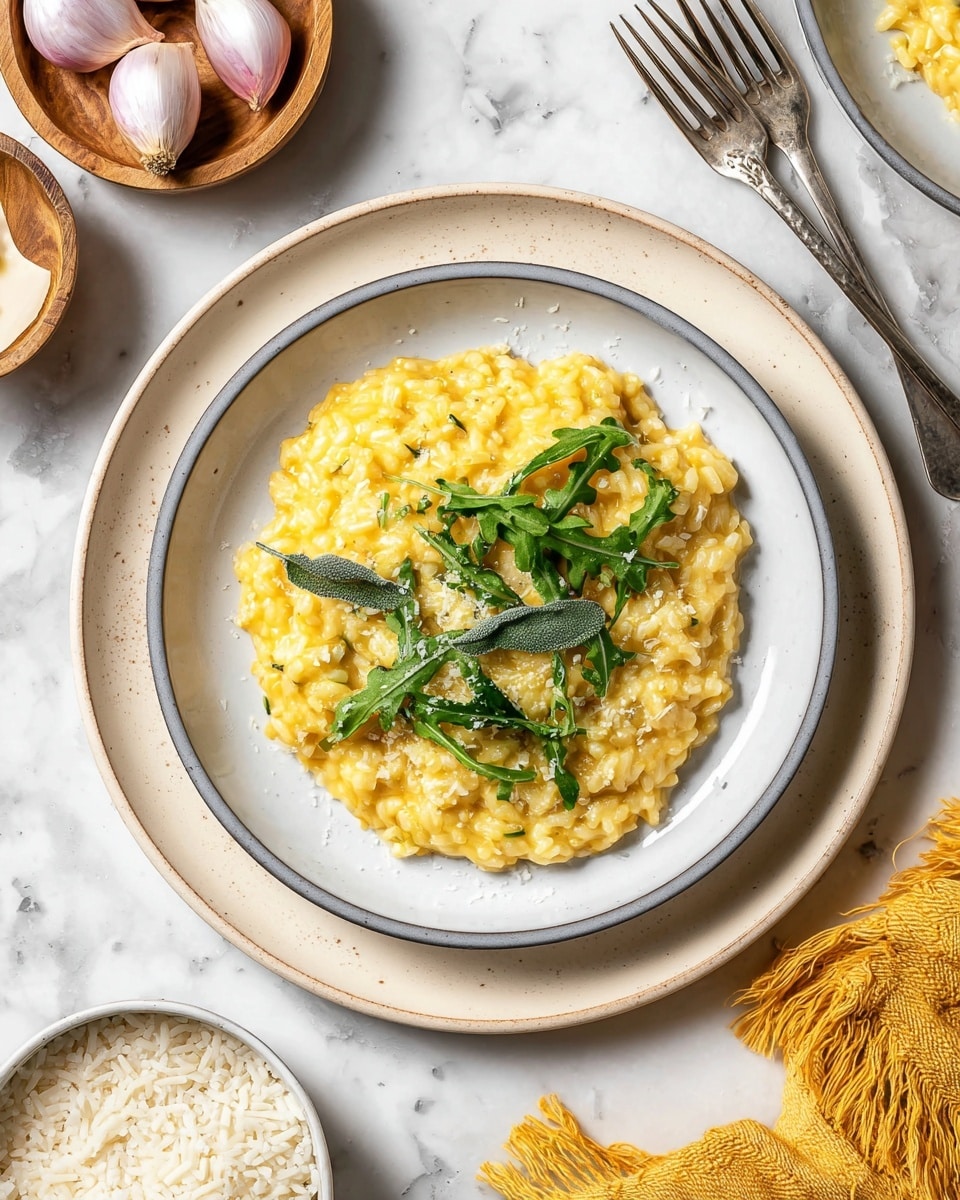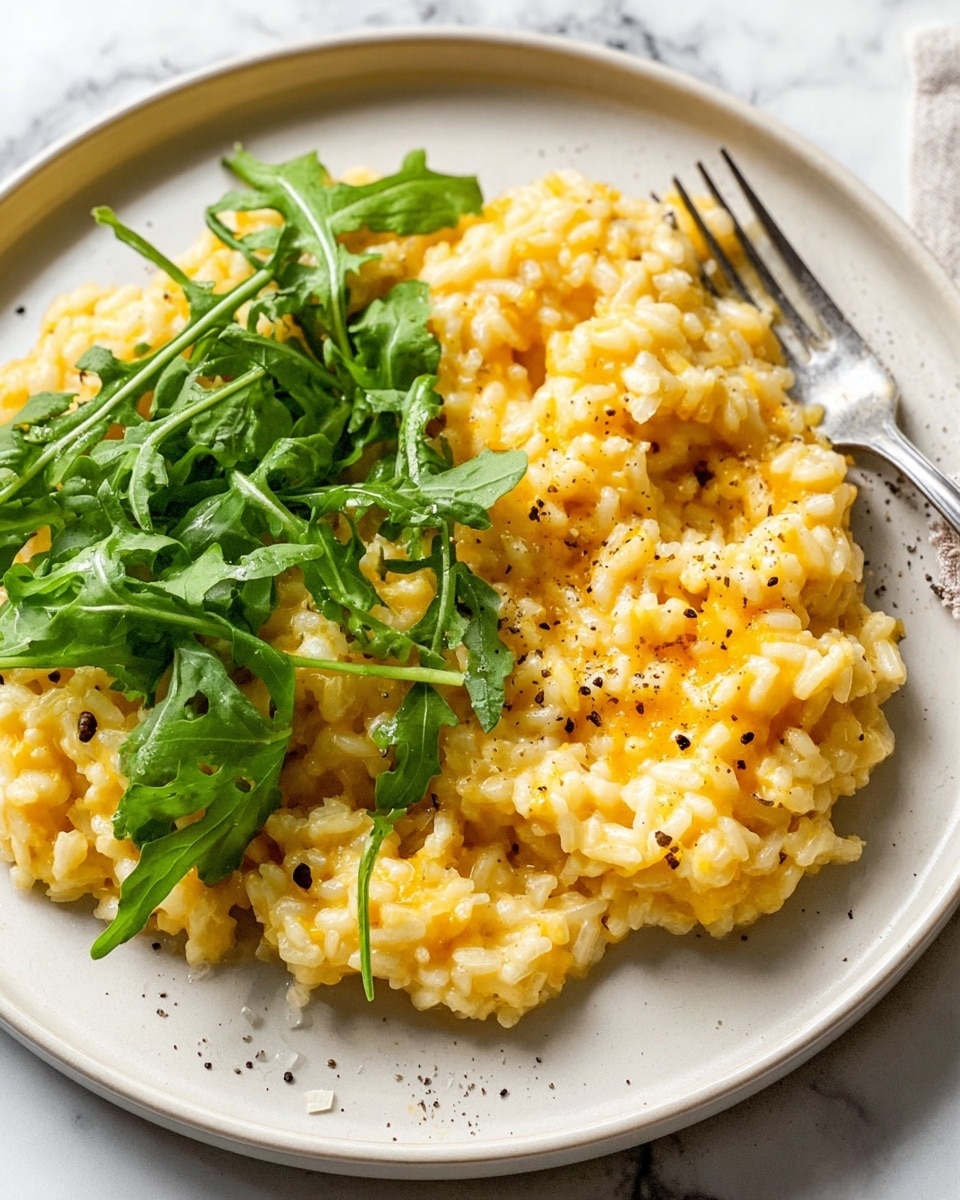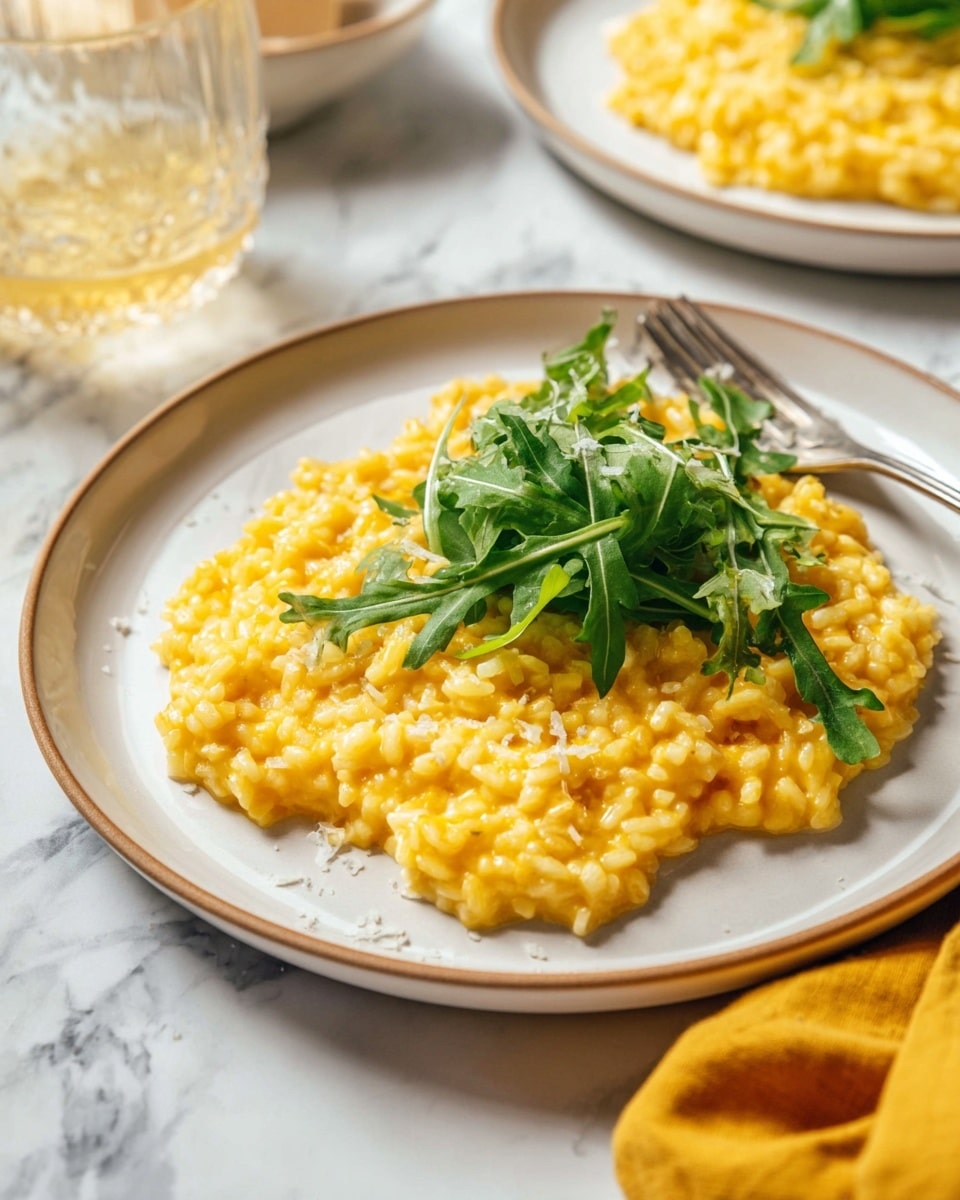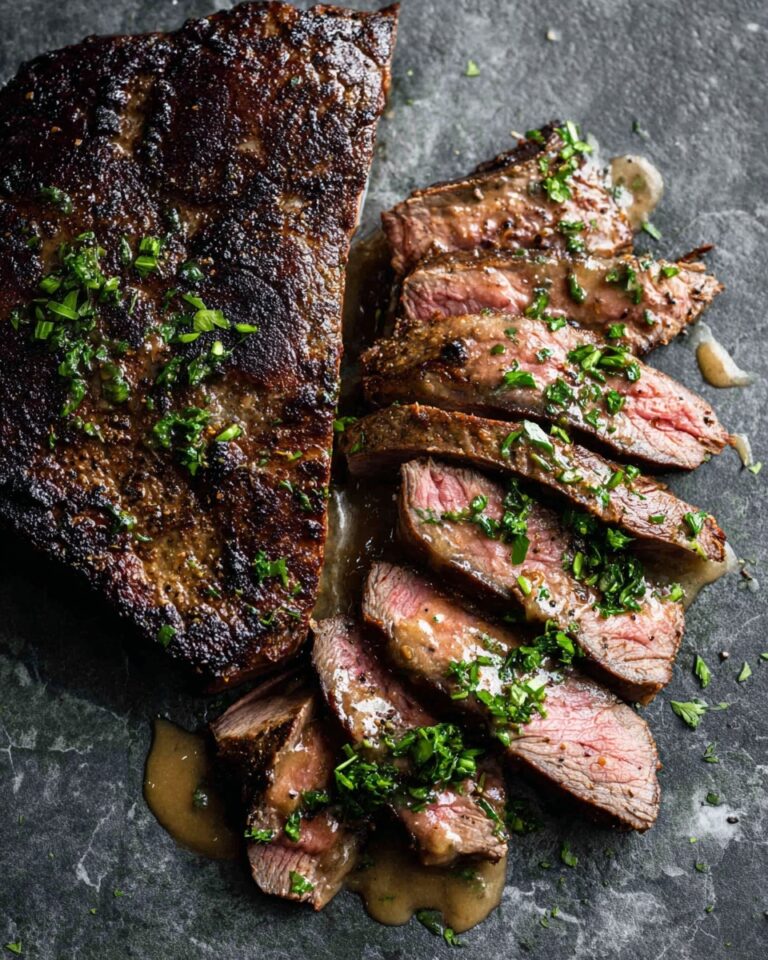I absolutely love this Butternut Squash Risotto Recipe because it feels like a warm hug in a bowl — creamy, comforting, and just a little bit fancy. The natural sweetness from the butternut squash pairs beautifully with the savoriness of the Parmesan and the earthiness of sage, creating a dish that’s somehow both simple and impressive at the same time. Whether you’re cooking for a cozy weeknight dinner or want to wow guests without too much fuss, this risotto is a winner.
When I first tried making butternut squash risotto, I was honestly intimidated by the stirring and ladling process, but once I got into the rhythm, I found it incredibly soothing and rewarding. You’ll find that the key is patience — letting the rice slowly soak up all the flavorful broth and squash puree will transform it into that perfect creamy texture we all crave. Trust me, it’s totally worth the hands-on time!
Why You’ll Love This Recipe
- Comforting and Creamy: The slow simmer and stirring release starches for a silky, luscious texture.
- Natural Sweetness: Butternut squash adds a delicate sweetness without overwhelming the dish.
- Impressively Simple: Uses everyday ingredients but feels like a special-occasion meal.
- Versatile and Adaptable: Easy to tweak for vegetarian diets or add your favorite herbs.
Ingredients You’ll Need
Every ingredient in this Butternut Squash Risotto Recipe works together to build layers of flavor and create the perfect creamy texture. Fresh herbs and good-quality cheese really take this from simple to stunning, so don’t skimp when shopping!
- Low-sodium chicken broth or vegetable broth: Using low-sodium gives you control over saltiness and keeps the risotto light.
- Butternut squash puree: Homemade or store-bought, this adds beautiful color and natural sweetness.
- Butter or olive oil: Helps sauté and enrich the flavor base.
- Garlic: Fresh and chopped for aromatic depth.
- Shallots: Milder than onions, they soften the flavor without overpowering.
- Arborio rice: The star of risotto, it absorbs liquid without losing structure.
- Dry white wine: Adds acidity and complexity (optional but recommended).
- Fresh sage: Herbaceous note that complements butternut squash perfectly.
- Parmigiano-Reggiano cheese: Freshly grated for maximum savory impact.
- Salt and freshly cracked pepper: To balance and enhance all the flavors.
- Baby arugula: Adds peppery freshness as a garnish.
Variations
I love that this Butternut Squash Risotto Recipe is a great foundation for tweaks — whether you’re cooking for vegetarians, avoiding wine, or looking to add a little twist. Feel free to make it your own!
- Vegetarian Version: Swap chicken broth for vegetable broth and skip the butter for olive oil to keep it lighter — it still tastes incredible.
- Herb Variations: I sometimes replace or add thyme or rosemary for a different earthy twist; it’s fun to experiment.
- Dairy-Free Option: Use nutritional yeast instead of cheese and olive oil in place of butter to keep creaminess without dairy.
- Extra Veggies: Toss in sautéed mushrooms or spinach near the end for more texture and nutrients.
How to Make Butternut Squash Risotto Recipe
Step 1: Warm Your Broth and Butternut Squash Puree
Start by combining your low-sodium broth and butternut squash puree in a large saucepan and heating it over medium-high heat. Once it boils, reduce the heat to low and keep it at a gentle simmer — this warm liquid is what the rice will slowly absorb. I always taste the broth at this point and add a pinch of salt if needed because it’s important for seasoning from the start.
Step 2: Sauté Aromatics and Toast the Rice
In a heavy-bottomed pan over medium heat, melt your butter or warm the olive oil. Add the chopped shallots and garlic and sauté for about two minutes until they’re fragrant and soft but not browned. Add the arborio rice and stir for another two to three minutes so each grain gets coated and starts to toast — this step adds flavor and helps the rice cook evenly.
Step 3: Deglaze with White Wine and Add Sage
Pour in the dry white wine and stir gently until it’s mostly absorbed by the rice. Then add the minced fresh sage, stirring it in to release those amazing herbal aromas. If you don’t use wine, just skip this step and move directly to adding the broth; it’s still fabulous.
Step 4: Ladle in the Broth Gradually, Stirring Constantly
This is where the magic happens: add a ladleful of your hot broth and butternut squash mixture to the rice. Stir gently and wait until the liquid is almost fully absorbed before adding the next ladleful. This slow, gentle cooking process releases the starch from the rice, creating that signature creamy risotto texture. Plan on doing this for about 25-30 minutes — don’t rush! You’ll want the rice to be tender but still have a slight bite (al dente).
Step 5: Finish with Cheese and Serve Immediately
Once all the broth is incorporated and your risotto is beautifully creamy, stir in the freshly grated Parmigiano-Reggiano cheese off the heat. Season with salt and freshly cracked pepper to taste. Serve immediately, topping each portion with a handful of fresh baby arugula for a peppery bite and optionally a little more cheese — it’s such a simple garnish but adds a lovely contrast in flavor and texture.
Pro Tips for Making Butternut Squash Risotto Recipe
- Patience is Key: Don’t add the broth too quickly; waiting for absorption leads to that creamy texture.
- Freshly Grated Cheese: I always grate my own Parmigiano-Reggiano for a much richer flavor than pre-grated options.
- Frequent Stirring: Stir often but gently to release the rice’s starch without breaking the grains.
- Use a Heavy-Bottomed Pan: It ensures even heat distribution and prevents sticking or burning at the bottom.
How to Serve Butternut Squash Risotto Recipe

Garnishes
I love topping this risotto with fresh baby arugula because it adds a nice peppery bite and reduces some of the richness. A sprinkle of extra Parmigiano-Reggiano or even some toasted pumpkin seeds gives lovely texture contrast. Sometimes I drizzle a little good-quality olive oil for extra silkiness!
Side Dishes
This butternut squash risotto pairs beautifully with simple green salads or roasted vegetables like Brussels sprouts or asparagus. If I want a protein side, grilled chicken or pan-seared salmon complements the creamy risotto nicely without overpowering it.
Creative Ways to Present
For special occasions, I sometimes serve this risotto in shallow bowls topped with a crisp sage leaf or a small dollop of mascarpone for an elegant touch. Another fun presentation is using roasted butternut squash bowls as edible “containers” — it’s as impressive as it is tasty!
Make Ahead and Storage
Storing Leftovers
I keep leftovers in an airtight container in the fridge for up to two days. Because risotto thickens as it cools, it’s often firmer than when freshly made, so you’ll want to loosen it up when reheating.
Freezing
I don’t often freeze butternut squash risotto because the texture can get a bit off, but if you do, freeze it in a shallow container for faster thawing. Thaw overnight in the fridge and reheat gently with a splash of broth or water to restore creaminess.
Reheating
To reheat, I recommend warming it on the stove over low heat with a little broth or water, stirring frequently to bring back that creamy texture. Microwaving works too but can be uneven, so add liquid and stir halfway through.
FAQs
-
Can I use canned butternut squash puree for this risotto?
Yes, canned butternut squash puree works well if you don’t have fresh squash on hand. Just be sure to choose a brand without added sugars or spices to keep the flavor balanced. You might want to taste the broth mixture before adding salt since canned puree can sometimes be a bit salty or sweet.
-
What wine do you recommend for this Butternut Squash Risotto Recipe?
I usually use a dry white wine like Pinot Grigio or Sauvignon Blanc. These wines add a nice acidity and crispness without overpowering the delicate squash flavor. If you prefer to skip alcohol, just leave it out and increase the broth slightly.
-
How do I know when the risotto is done?
Risotto should be tender but still slightly firm to the bite—what Italians call “al dente.” The texture should be creamy and flowing, not dry or mushy. Taste-testing as you go is the best way to check since every stove and pan cooks a bit differently.
-
Can I make this risotto vegan?
Absolutely! Use vegetable broth, swap butter for olive oil, and replace Parmesan with a vegan cheese or nutritional yeast for a cheesy flavor. Fresh herbs will still shine and make it delicious.
-
Is it okay to use pre-grated Parmesan cheese?
Pre-grated cheese is convenient but lacks the fresh flavor and texture of freshly grated Parmigiano-Reggiano. I highly recommend grating your own cheese for this risotto to maximize taste and creaminess.
Final Thoughts
This Butternut Squash Risotto Recipe has truly become one of my go-to dishes whenever I want something cozy that feels a little special. It’s the kind of recipe you can enjoy on a chilly evening but also serve up for guests who’ll think you spent hours in the kitchen. Don’t be daunted by the stirring—it’s almost meditative once you get the hang of it, and the creamy, flavorful result is pure comfort. Give it a try and let me know how it turns out for you—I’m pretty sure it’ll become a new favorite in your home, just like it did in mine!
Print
Butternut Squash Risotto Recipe
- Prep Time: 10 min
- Cook Time: 45 min
- Total Time: 55 min
- Yield: 4 servings
- Category: Main Course
- Method: Stovetop
- Cuisine: Italian
- Diet: Vegetarian
Description
This creamy Butternut Squash Risotto combines tender arborio rice with sweet butternut squash puree, fresh sage, and Parmesan cheese to create a comforting and flavorful dish. Perfect as a vegetarian main course or a lavish side, the risotto is enriched with garlic and shallots, slowly cooked to a luscious consistency and garnished with peppery baby arugula for freshness.
Ingredients
Broth and Puree
- 3 cups fat free low-sodium chicken broth (use vegetable broth for vegetarian)
- 1 cup butternut squash puree*
Base Ingredients
- 1 tsp butter or olive oil
- 3 cloves garlic, chopped
- 1/4 cup shallots, chopped
- 1 cup arborio rice
- 2 oz dry white wine
- 1 tbsp fresh sage, minced
Finishing Touches
- 1/4 cup freshly grated Parmigiano-Reggiano
- Salt and fresh cracked pepper, to taste
- 2 cups fresh baby arugula (for garnish)
Instructions
- Prepare the broth and puree: In a large saucepan, combine the chicken or vegetable broth with the butternut squash puree. Heat over medium-high heat until boiling, then reduce to a low simmer. Taste and season with salt if needed. Keep this warm throughout the cooking process.
- Cook the aromatics and rice: In a large heavy saucepan over medium heat, melt the butter or heat the olive oil. Add the chopped shallots, garlic, and arborio rice. Sauté for about 3 minutes, stirring occasionally, until the rice is well coated and slightly translucent.
- Add wine and sage: Pour in the dry white wine along with the minced fresh sage. Stir continuously until the wine is fully absorbed by the rice, imparting a fragrant flavor base.
- Incorporate broth gradually: Start adding a ladleful of the warm broth mixture to the rice. Stir gently and almost constantly, waiting for each addition to almost fully absorb before adding the next ladleful. This slow addition and steady stirring release the rice’s starch, creating a creamy texture. Continue this process for about 25-30 minutes, until the rice is tender but still slightly firm at the center, and the broth is fully incorporated.
- Finish with cheese and seasoning: Once all liquid is absorbed and the risotto is creamy, stir in the grated Parmigiano-Reggiano cheese. Remove the pot from heat and adjust seasoning with salt and freshly cracked pepper as desired.
- Serve garnished: Serve the risotto immediately, topped with fresh baby arugula and additional grated cheese if you prefer, to add a peppery, fresh contrast to the rich dish.
Notes
- Use freshly grated cheese such as Parmigiano-Reggiano or Pecorino Romano for the best flavor intensity instead of pre-grated options.
- Don’t rush the risotto by adding broth too quickly. Patience is key to achieving perfect creaminess.
- Stir frequently to release the starch from the rice; this is what makes the risotto luxuriously creamy.
Nutrition
- Serving Size: 1 scant cup
- Calories: 249 kcal
- Sugar: 1 g
- Sodium: 461 mg
- Fat: 3 g
- Saturated Fat: 1.5 g
- Unsaturated Fat: 1.5 g
- Trans Fat: 0 g
- Carbohydrates: 45 g
- Fiber: 1 g
- Protein: 7.5 g
- Cholesterol: 5 mg









